2024.06.03
- Features
-
Services/ProductsServices/ProductsServices/Products

Learn more about the retail trading conditions, platforms, and products available for trading that FXON offers as a currency broker.
You can't start without it.
Trading Platforms Trading Platforms Trading Platforms
Features and functionality comparison of MetaTrader 4/5, and correspondence table of each function by OS
Two account types to choose
Trading Account Types Trading Account Types Trading Account Types
Introducing FXON's Standard and Elite accounts.
close close

-
SupportSupportSupport

Support information for customers, including how to open an account, how to use the trading tools, and a collection of QAs from the help desk.
Recommended for beginner!
Account Opening Account Opening Account Opening
Detailed explanation of everything from how to open a real account to the deposit process.
MetaTrader4/5 User Guide MetaTrader4/5 User Guide MetaTrader4/5 User Guide
The most detailed explanation of how to install and operate MetaTrader anywhere.
FAQ FAQ FAQ
Do you have a question? All the answers are here.
Coming Soon
Glossary Glossary GlossaryGlossary of terms related to trading and investing in general, including FX, virtual currencies and CFDs.
News News News
Company and License Company and License Company and License
Sitemap Sitemap Sitemap
Contact Us Contact Us Contact Us
General, personal information and privacy inquiries.
close close

- Promotion
- Trader's Market
- Partner
-
close close
Learn more about the retail trading conditions, platforms, and products available for trading that FXON offers as a currency broker.
You can't start without it.
Features and functionality comparison of MetaTrader 4/5, and correspondence table of each function by OS
Two account types to choose
Introducing FXON's Standard and Elite accounts.
Support information for customers, including how to open an account, how to use the trading tools, and a collection of QAs from the help desk.
Recommended for beginner!
Detailed explanation of everything from how to open a real account to the deposit process.
The most detailed explanation of how to install and operate MetaTrader anywhere.
Do you have a question? All the answers are here.
Coming Soon
Glossary of terms related to trading and investing in general, including FX, virtual currencies and CFDs.
General, personal information and privacy inquiries.
Useful information for trading and market information is posted here. You can also view trader-to-trader trading performance portfolios.
Find a trading buddy!
Share trading results among traders. Share operational results and trading methods.
- Legal Documents TOP
- Client Agreement
- Risk Disclosure and Warning Notice
- Order and Execution Policy
- Complaints Procedure Policy
- AML/CFT and KYC Policy
- Privacy Policy
- eKYC Usage Policy
- Cookies Policy
- Website Access and Usage Policy
- Introducer Agreement
- Business Partner Agreement
- VPS Service Terms and Condition

This article was :
published
updated
Weekly FX Market Review and Key Points for the Week Ahead
In the week ending June 2, overall currency trends included a strengthening dollar and yen, with the USDJPY in a short downward retrace after exceeding 157.5. The EURUSD was mostly aimless, trending between 1.08 and 1.09. Meanwhile, the GBPUSD reversed its climb after reaching just below 1.28.
The EURJPY and GBPJPY also bottomed out on Thursday due to a strengthening yen, but effected a robust rebound thereafter.
Let's review the market movements through the week.
In the period from Monday, May 27 to Wednesday, May 29, there were no key economic indicators pertaining to the dollar, yen, euro, or pound.
On Thursday, May 30, the U.S. released its annualized quarter-on-quarter data for quarterly real GDP (revised data) from January to March, showing an increase of 1.3% matching an expected 1.3%.
On Friday, May 31, preliminary data for the Eurozone's May Harmonised Index of Consumer Prices (HICP) were released. Year-on-year data showed growth of 2.6% versus an expected 2.5%. For the core index, year-on-year growth was 2.9% versus an expected 2.7%.
This indicator release triggered a rally in the EURUSD, which reached a high of 1.0882.
Friday also marked the release of the much-awaited U.S. personal consumption expenditures (PCE) data for April. The PCE deflator year-on-year data came in at 2.7% vs. 2.5% expected. When excluding food and energy, the PCE deflator showed a 0.2% month-on-month increase vs. 0.3% expected, and was up 2.8% year on year vs. 2.8% expected.
This new indicator triggered a drop in the USDJPY to 156.56, but the pair rebounded to close the week above 157.
Economic Indicators and Statements to Watch this Week
(All times are in GMT)
June 3 (Mon)
14:00, U.S.: May ISM Manufacturing PMI
June 5 (Wed)
12:15, U.S.: May ADP National Employment Report (month-on-month data)
14:00, U.S.: May ISM Non-Manufacturing PMI (composite)
June 6 (Thu)
12:15, Europe: European Central Bank (ECB) Governing Council policy interest rate announcement
12:45, Europe: Regular press conference by European Central Bank (ECB) President Christine Lagarde
June 7 (Fri)
09:00, Europe: January-March quarterly regional gross domestic product (finalized regional GDP, quarter-on-quarter data)
09:00, Europe: January-March quarterly regional gross domestic product (finalized regional GDP, year-on-year data)
12:30, U.S.: May change in nonfarm payrolls (month-on-month data)
12:30, U.S.: May unemployment rate
12:30, U.S.: May average hourly earnings (month-on-month data)
12:30, U.S.: May average hourly earnings (year-on-year data)
Like many weeks falling in the early month, this one will host a great deal of important economic indicator released. Of these, the most highly-watched will certainly be Friday's release of several U.S. employment statistics. The previous release showed worse-than-expected job growth, which led to a sell-off in the dollar, driving down the USDJPY.
The CME's FedWatch tool shows that the September FOMC meeting is the first where the probability of an interest rate cut exceeds that of an unchanged interest rate. With two more FOMC meetings in 2024, November and December, a rate cut in September could signal as many as three cuts by the end of the year.
It is highly advisable to keep an occasional eye on economic indicators and key statements, including this week's employment report, as any sign of receding inflation or negative economic data would enhance the probability of a rate cut.
This Week's Forecast
The following currency pair charts are analyzed using an overlay of the ±1 and ±2 standard deviation Bollinger Bands, with a period of 20 days.
USDJPY
In addition to the aforementioned Friday release of employment statistics, the week will see the release of several other important U.S. economic indicators, including the ADP National Employment Report and the ISM. The pair has largely recouped losses from its intervention-driven fall during Japan's Golden Week holiday period, and it will be interesting to see if the USDJPY will once again test the 160 level.
Next is an analysis of the USDJPY daily chart.
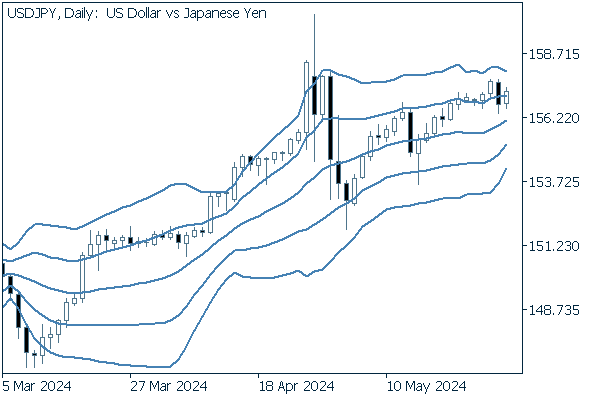

The pair has generally remained above the Bollinger Bands' middle line. The upper and lower band widths are narrowing, with the pair appearing to be conserving energy for a trend reboot.
We continue with an analysis of the USDJPY weekly chart.
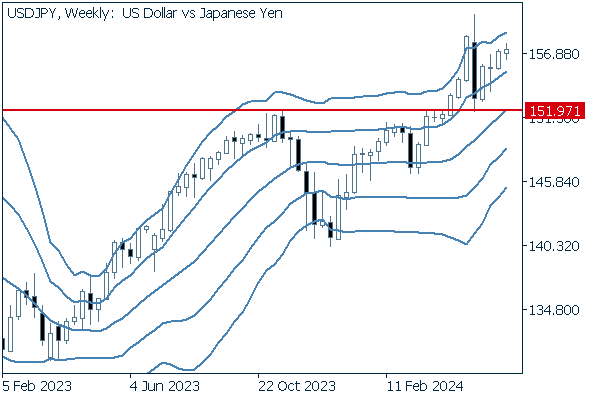

The pair has remained above 152 and has begun to move between the +1 and +2 standard deviation Bollinger Bands, which could lead it to mark higher highs on the chart.
EURUSD
Notable euro-related developments include the quarterly GDP to be released on Friday. In the past few years, markets have largely been dominated by U.S. monetary policy, with many instances of minimal reaction to euro-related economic indicators. It may be more effective to base trades primarily on movements in the dollar.
Next is an analysis of the EURUSD daily chart.
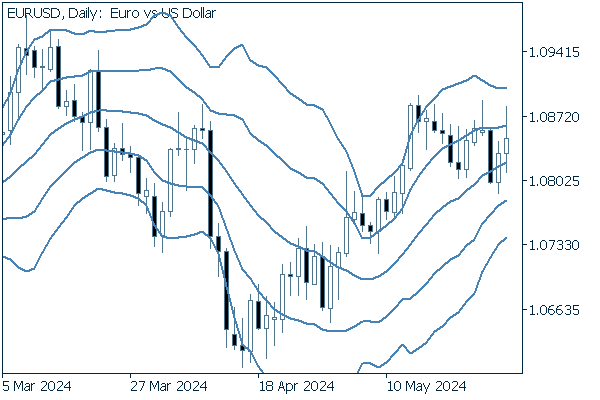

Though the middle Bollinger Band is climbing upward, the most recent price trend has been directionless. There is a potential case for the pair surpassing the +1 standard deviation Bollinger Band and re-entering a bullish trend.
We continue with an analysis of the EURUSD weekly chart.
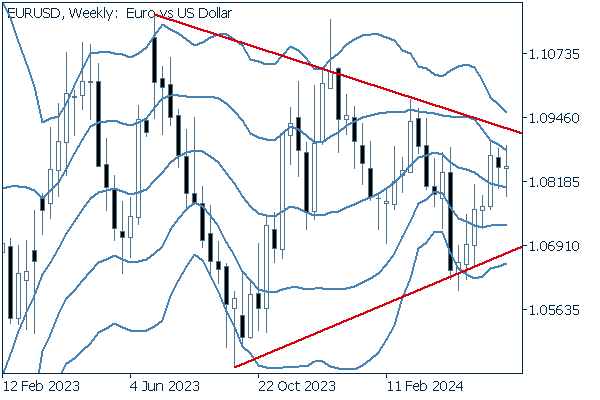

Looking over a longer weekly timeline, the pair is still trading in a triangle formation. For the moment, the pair appears to be positioned closer to the upper side of the formation.
GBPUSD
The coming week will yield no economic indicators of high importance in relation to the pound. As with the EURUSD, trades will watch the movements of the dollar.
Now, we analyze the daily GBPUSD chart.
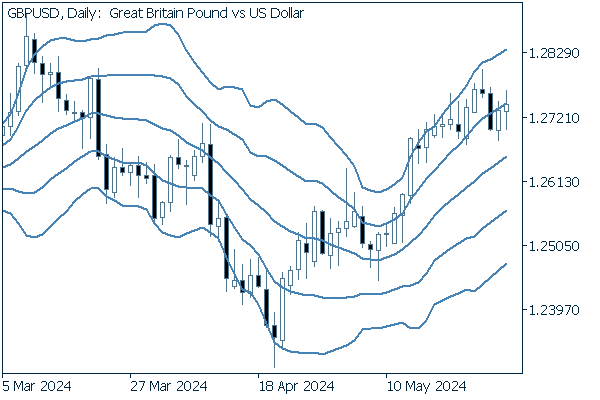

Though the pair had been in a sustained bandwalk, it has closed below the +1 standard deviation Bollinger Band. With a climbing middle Bollinger Band, there is a case for the pair extending gains if it breaks above the +1 standard deviation band.
We continue with an analysis of the GBPUSD weekly chart.
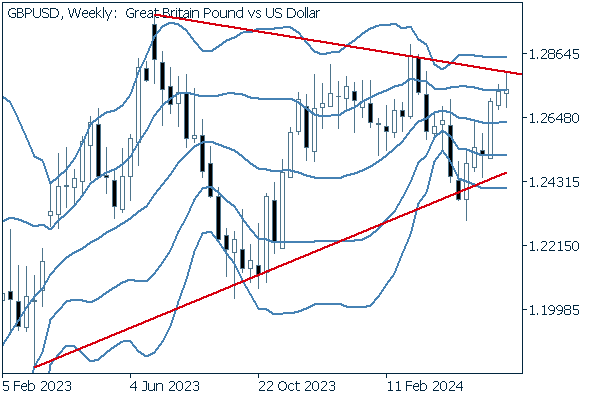

Like the EURUSD, this pair is also trading inside a triangle formation, but the tip of the whisker for last week has touched the triangle's upper edge. A dollar weakening from here could lead to an upward breakout scenario.
Was this article helpful?
0 out of 0 people found this article helpful.
Thank you for your feedback.
FXON uses cookies to enhance the functionality of the website and your experience on it. This website may also use cookies from third parties (advertisers, log analyzers, etc.) for the purpose of tracking your activities. Cookie Policy
